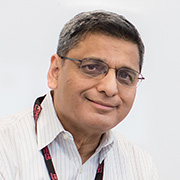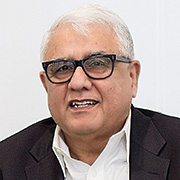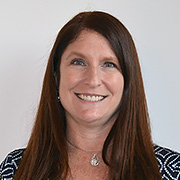2018年6月18日
日立は2017年4月、日立の「Lumada」の革新的ソリューション開発の加速に向け、グローバル研究チーム「Insights Laboratory」を発足した。Beverly
The majority of our customers are trying to figure out the first step towards digitization. This is why Hitachi is taking a co-creation and incubation approach – because customers are being overwhelmed by the digital journey. We can give them something comprehensible and become that trusted advisor who can tell the whole digital story and help them grow.

Brad
I think you hit the nail on the head. Each customer is looking for a journey map. We start with very pragmatic discussions around data center modernization and a framework we call SEAM: Store, Enrich, Activate, and Monetize. By using this framework as the basis for their digitization, customers develop changing business models as they monetize their data. But first we have three big conversations around the data infrastructure they need and data center modernization, intelligent data governance, and the way they derive insights from their data. These conversations lead to the specific road maps and the maturity levels they’ll need to scale their pilots to where they have a major impact.

Brijesh
Customers love this idea of co-creation - that there is this joint participation to help identify and resolve their issues, and to grow together. But the ROI discussion is extremely important right up front. There’s a huge interest in asset efficiencies and asset utilization. We also hear a lot about operational excellence, quality and efficiency. The initial incubations that Hitachi’s Global Center for Social Innovation (CSI) has done around these areas are really synchronizing with the marketplace.

Umesh
Yes, the Insights Lab is in a unique position to work with customers and partners. We have a global team of researchers and designers from CSI and Center for Technology Innovation (CTI), focusing on innovative new solutions and the agile co-creation of digital solutions using analytics, artificial intelligence (AI), advanced machine learning and so on. Oftentimes we find the conversation has to start with identifying the insight they are trying to get – what’s the issue? Is it operational efficiency or quality of manufacturing operations? Is it yield or a safety issue? We can often extract a few common horizontal themes and build solutions around these.
Optimizing operations as well as the entire value chain, increasing asset availability and dependability – these are important issues. And some are looking to transform their business models as well, so they can move from a pure product place to becoming a service provider for their customers. This is an opportunity for us to help in the entire stack, introducing how we use AI machine-learning and advanced analytic techniques to unlock the value of that data so they can see the value of these insights in terms of their business operations.
Brad
Identifying the customer’s pain point or business objective is the beginning of the journey map for digital transformation. With this defined, we can position the journey’s start appropriately. Hitachi Vantara’s role is to unlock the synergy between the CSI labs and the business units. Customers are finding that their existing systems are more of a barrier than they expected. We can help our customers manage the object store technology and the data infrastructure, giving them more agility with their data.
Every part of the portfolio and research areas must be leveraged for an edge-to-cloud or, for industrial players, controls-to-cloud digital infrastructure that enables operations intelligence-style outcomes. If we can find a way to pick more of the semantics of the apps and put them into the infrastructure layers, the apps will become easier to develop. It will be faster and easier for customers to try new business models and be experimental about new ways to monetize their assets and data. By pulling together different kinds of data, different velocities and qualities and analyzing it in a cost-effective way, we create the outcomes they need. This is one way we can simplify the move to business model innovation for our customers.
Beverly
We take an innovative approach by bringing in industry experts – and not just technologists – to go out with the sales forces and enable conversations they couldn’t have had without them. With co-creation, we’re asking the customer what outcomes they’re looking for and work backwards from that.
Brijesh
The Social Innovation Business team engages with the customers to identify problems that potentially could give them a huge return on investment (ROI) and a competitive advantage. Usually we look for point solutions and we try to solve the problem as a first-of-a-kind solution using big data analytics. That’s a starting point for incubating the solutions.
Having the data infrastructure enable more DataOps, the way you get DevOps on the development side, is going to help address data engineering challenges and the big costs associated with wrangling the data. Moving from one-directional predictive maintenance and predictive analytics on sensor data, moving back into specific use cases where we can actuate a control – there’s big value there for the industrials. We want to be able to say we have this controls-to-cloud data infrastructure to enable your operations intelligence.
I’m going to add one more item and that’s repeatability. Customers are asking if we can make it repeatable from one solution to another. When moving from one use case to another, they don’t want to spend the same amount of money and effort starting over. They also don’t want to build another UI or dashboard. Essentially, it’s about repeatability.
Umesh
Absolutely. Repeatability of both the data flow and the analytics pipelines and then the dashboard, and then the controls, too. This is an area we’ve started to focus on in the research labs: How do we derive insights from data? What is the best action you can take and how do you turn these into actionable insights? In the case of a lot of these operational solutions, you have to be able to actuate so the question becomes: How do we marry AI machine-learning with controls? I think that’s where Hitachi has unique advantage because we have people with deep expertise on operational technology (OT) systems and we pair that with a lot of what we are doing on the machine-learning side.
Beverly
Absolutely. We have the subject matter experts and decision-support systems – the best and the brightest – and we are changing the systems. I’ve actually found two ways in which we are set apart from the industry no matter what internet of things (IoT) solution you are looking at. One is that we are humble. By this I mean that we don’t pretend to know all the answers. We tell the customer we want to co-create with you because we don’t know your issues and we want to take your knowledge and our knowledge and blend it together. The other differentiator is our humanness. We look at the human systems as well as the mechanical systems and we look at the processes and what the impact is on the system.
Umesh
The Insights Lab has become a center of excellence for analytics and machine learning and AI. It is important that we maintain our alignment with product and go-to-market strategies. We’ve talked about several areas: making the data pipeline work out of the box for solutions we’re building, driving down the application semantics into the infrastructure side and out into the edge. Other areas include supporting richer content types including video content so they’re easier to work with; and the coming together of AI and machine learning and controls and then scaling out to end-to-end optimization for complex multi-party systems. We’re looking at micro app architecture as well.
Brad
All of the pieces you mentioned aren’t siloed and that’s an important part as we work at this distributed architecture and data architecture that is evolving from hyperscale and hybrid clouds, and on-premises and edge-based storage. I think that also creates challenges for the data pipeline around, how to manage this distributed orchestration of data, the distributed ingestion of data, and the distributed analytics of the data on that edge-to-cloud or controls-to-cloud data infrastructure.
Brijesh
The business units want new use cases and solutions and help creating the new business models including big data analytics modeling support. The proof of concepts, or PoCs, that CSI is conducting are all customer-related. That means there was a need in the marketplace. Although they are first-of-a-kind projects, we have done the market research to know it has market potential. As soon as we start doing an incubation project, we bring in the business unit and get them involved whether it’s for the delivery of the solution or participating in the incubation itself. Also, it is important for research not to be isolated from the marketplace. We are taking the researchers to the customer and have them listen to what the customer needs.
Beverly
I’m looking for what the next best thing is that can be commercialized; solutions that are repeatable and will draw customers. We need market agreement, we need integrators, and we need everyone working as an ecosystem in order to be effective.
Brad
The more agile we can be; the better. If we make this a real partnership model working with research, we can work together around product strategy. Look at how the market is evolving, what are some of the technical differentiators today and where those trends are going, and then see how we can be on the leading edge of those trends by investing in those technologies and having the flexibility to adapt as we see new opportunities and solutions in the market start to really take off. We need to have a long-term vision for our products and where they’re going and make the right kind of technology investments to maintain a lead, but we need to be agile enough to pivot as we see an opportunity in the short term, and to adapt to the market as it changes.
Umesh
We have the technologies and the methods to extract the knowledge directly from the data and then automate. It’s not just about ingesting data and providing intelligence for human decision making. We want to take that and write it back into the control systems. We’re also exploring open innovation by reaching out to some of our research collaborators at universities and national labs to see if we can build on some of the work being done there and provide our practical experience, building out some of these solutions into the research programs.
Hitachi is collaborating with customers, partners, and academic research centers worldwide to resolve issues facing society and organizations by co-creating advanced technologies and total solutions – striving for a better future for all. Future conversations in this series will focus on how Hitachi is pushing the boundaries of innovation with customer-driven solutions using AI, analytics and IoT in co-creation and other initiatives to deliver results that make a difference.
※ 所属、役職は公開当時のものです。

Umeshwar Dayal, Ph.D.
Sr. Vice President & Sr. Fellow – Information Research,
Hitachi America, Ltd.
Global Center for Social Innovation-North America,
Global Head of the Insights Laboratory
Umesh is responsible for research and technology innovation in big data, advanced analytics, and AI, leading to the creation of novel solutions in various industries, including manufacturing, energy, natural resources, healthcare, and transportation, and has over 35 years of research and innovation experience in all aspects of data management and analytics. He joined the Research and Development Division of Hitachi America, Ltd. in 2013. Prior to joining Hitachi America, Umesh was an HP Fellow and Director of the Information Analytics Lab at Hewlett-Packard Labs, Palo Alto, California.
Umesh received his Ph.D. in Applied Mathematics from Harvard University. He is a Fellow of the Association for Computing Machinery (ACM), and has received the Edgar F. Codd Award from the ACM Special Interest Group on Data Management (SIGMOD) for fundamental contributions to data management. He has published over 240 research papers and holds over 60 patents.

Brijesh Khanna
Sr. Vice President and Innovation Leader,
Social Innovation Business, Hitachi, Ltd.
Brijesh is responsible for incubating CSI solutions from concept to commercialization through co-creation with customers and partners. Brijesh joined Hitachi in March of 2014 to help Hitachi America develop into an IoT solutions organization. He is responsible for conceptualizing, creating and then going-to-market with end-to-end IoT and big data solutions across multiple verticals of Hitachi, Ltd. These are unique one of kind big data and IoT solutions that reduce cost, increase profitability and radically change a customer’s business. Prior to joining Hitachi, Brijesh was at GE Digital Energy and was responsible for building SaaS-based Smart Grid solutions.
Brijesh holds a B.Eng. in Electrical and Electronics Engineering from Birla Institute of Technology and Science, Pilani, India.

Beverly Rider
Sr. Vice President and Chief Commercial Officer – Americas,
Social Innovation Business, Hitachi, Ltd.
Beverly joined Hitachi, Ltd. in 2017 in an effort to broaden her work in Industrial IoT and smart cities. She is currently Senior Vice President and Chief Commercial Officer. Prior to her tenure with Hitachi, Beverly held positions as CCO of General Electric, VP & Head of IoT at Ericsson and CEO of C-level Consulting (a firm specializing in IoT and M2M solutions for smart cities and smart campuses). Beverly is passionate about enabling cities, citizens, corporations, and the environment to use technology for long-term sustainable growth, efficiencies, productivity and resilience. Prior to Beverly’s tenure in IoT, she was an executive for Qwest, US West, and as an associate attorney.
Beverly studied at the University of Washington, Western Washington University and Seattle University School of Law. She holds degrees in Finance, Marketing, and a J.D. cum laude.

Brad Surak
Chief Product and Strategy Officer,
Hitachi Vantara
Brad joins Hitachi Vantara with over 25 years of success in digital transformation, general management, product and solution development, software engineering and operations across multiple industries and geographies. He has demonstrated success in driving global digital transformations that deliver top-line growth and productivity. Prior to joining Hitachi, Brad led the formation of GE Digital, a General Electric business, and served as chief operating officer. An "intrapreneur," Brad comes with a proven history in building successful businesses within large multinational companies such as SAP and Business Objects. He has also held executive positions with DayNine, Cambridge Technology Partners and Ernst & Young’s technology practice.
Brad holds a B.Sc. in Computer Science from Purdue University and was awarded the title of Distinguished Science Alumni in 2017.